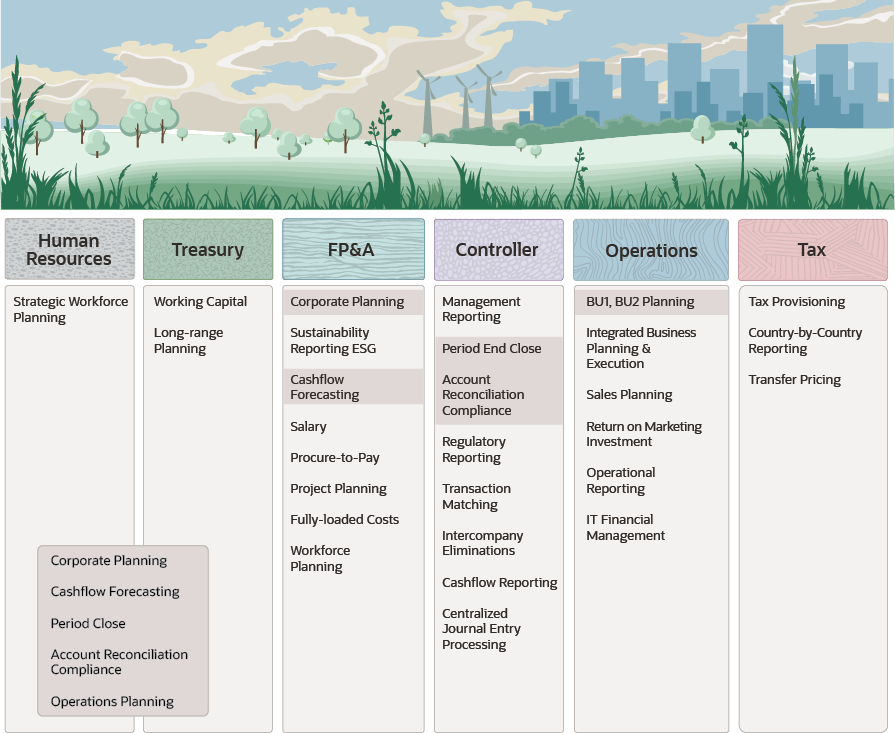Plan Your Roadmap
Plan the roadmap for your EPM CoE. This will help you phase in updates over time, such as AI and GenAI, and track your CoE's progress and speed of innovation.
The following graphic shows an example of an EPM CoE Roadmap that can help you define your own journey to the Cloud EPM. The best practice is to:
- Incorporate the company’s strategic initiatives in the roadmap. For example, if the planning process is the first of the EPM business processes to be modeled, this could take priority and result in the need for numerous planning applications. In this case, the role of the CoE is especially important to ensure rapid build of applications, consistency and standardization, integration, and common use of data and reporting.
-
Ensure that you leverage as many of the Cloud EPM platform capabilities as possible. One example is the work needed for reconciling accounts. Management, auditors, and others to ensure that every balance sheet account is accurately reconciled every period, at a minimum. If an organization has operations in multiple countries and industries, there can be thousands of balance sheet accounts to reconcile following the applicable accounting standards. This can all be completed in a single and centralized Cloud EPM process called Account Reconciliation. Another example is Task Manager, which enables the automation of business processes, tracking status, providing notifications and alerts, monitoring business process status dashboard, and more.
- Give business priorities careful consideration, especially when a hybrid approach represents the first part of the journey to the cloud. We have seen customers who were still running their financial consolidation process with Oracle’s Hyperion Financial Management application onpremises at the same time that they implemented planning applications in the cloud. In cases like this, it's important to consider data and metadata integrations, especially considering that Enterprise Data Management is part of the EPM solution.
- Maintain a constant balance between risk versus delivering on the roadmap. One of the risks we have seen is when administrators of Oracle Hyperion on-premise applications feel that they are ready to migrate their applications to Cloud EPM without further training or involving implementors. For example, while Oracle has migrated the capabilities that existed in Hyperion Financial Management and Hyperion Planning to Cloud EPM, numerous optimizations and improvements were also made on the cloud. Not being aware of these updates can result in duplication of work.
- Whether you’re just starting your journey to the cloud or are looking to innovate in new areas, you need the right tools to successfully reach your goals. Infused with insights from more than 10,000 Oracle Cloud implementations, Oracle Cloud Success Navigator helps you chart the best path forward for your business. With pre-configured starter environments, implementation guidance, key milestone tracking, AI assistance, quarterly release insights, and access to Oracle Modern Best Practices and quality standards, Success Navigator equips you with the tools you need to thrive in the cloud.
-
Augment the use of EPM with further analytics as described here.
- Plan to utilize these resources provided by EPM:
- Enroll in the Implementation Success Program (ISP) – this is a new concept for customers who have a background in on-premise applications. ISP strives to bring the application design expertise of the EPM Development teams to customer implementations through an expedited evaluation of application design document review. The review ensures that the application design adheres to Oracle recommended best practices. Learn more about this program.
- Understand which applications can be migrated.
- Stay current with cloud readiness information and What's New. You can also use the Oracle Cloud Application Update Readiness App to find updates from previous months.
- Know how to resolve issues.
- Be aware of the process to skip automatic updates for production environments.
- Review the Oracle roadmaps, which can be found here on Customer Connect.
Example of an EPM CoE Roadmap
This example shows how a CoE might decide to implement several initial business processes and features, indicated with a + (plus sign) in the graphic. Then, over time, they plan to bring in additional business processes and features that will benefit their organization.

Additional suggestions:
-
As you continue your Cloud EPM transformation, keep in mind that in organizations, while there are many departments and teams that have their own planning processes, these processes are often disconnected from Finance. To learn more about how to connect and improve planning across your enterprise, read about FreeForm and review the FreeForm library.
-
To ensure that your roadmap is aligned with Cloud EPM, you can request Cloud EPM roadmap information.
-
After you have gone live with a Cloud EPM business process, it is important to maintain a roadmap of deliverables by continuously reviewing the Cloud EPM roadmap and matching it against enhancement requests from your user base. Cloud EPM is continuously delivering new features, and not taking advantage of them could reduce the possible return on investment.
- Understand how to open an enhancement request.
-
It's a best practice to stay current with monthly updates. Create a testing strategy to ensure that monthly updates work well for your organization.
-
For additional information, review the Business as Usual topic.